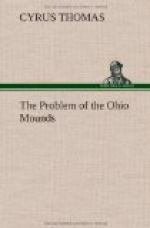As a general rule the strata are found in this order: (1) a top layer of soil from 1 foot to 2 feet thick; (2) a layer of burnt clay from 3 to 12 inches thick (though usually varying from 4 to 8 inches) and broken into lumps, never in a uniform, unbroken layer; immediately below this (3) a thin layer of hardened muck or dark clay, though this does not always seem to be distinct. At this depth in the mounds of the eastern part of Arkansas are usually found one or more skeletons.
Take, for example, the following statement by Dr. Edward Palmer in regard to these beds:
As a general and almost universal rule, after removing a foot or two of top soil, a layer of burnt clay in a broken or fragmentary condition would be found, sometimes with impressions of grass or twigs, and easily crumbled, but often hard, and stamped, apparently, with an implement made of split reeds of comparatively large size. This layer was often a foot thick, and frequently burned to a brick-red or even to clinkers. Below this would be found more or less ashes, and often 6 inches of charred grass immediately over the skeletons. These skeletons were found lying in all directions, some with the face up, others with it down, and others on the side. With each of these were one or more vessels of clay.
Remains of rectangular houses were also discovered, though much less frequent than other forms. These consisted of three rooms, two in front and one in rear. For example, Dr. Palmer found in a broad platform like elevation not more than 3 feet high the remains of a house of this form which he traced by the burnt clay. The lines of the upright walls were very apparent, as also the clay which must have fallen from them, and which raised the outer marginal lines considerably higher than the inner area. Dr. Palmer remarks:
The fire must have been very fierce, and the clay around the edges was evidently at some height above the door, as I judge from the irregular way in which it is scattered around the margins.
Excavations in the areas showed that they were covered with a layer of burnt clay, uneven and broken; immediately below this a layer of ashes 6 inches thick, and below this black loam. On these areas large trees were growing, one a poplar 3 feet in diameter. Below one of these floors were found a skeleton, some pottery, and a pipe. A large oak formerly stood at this point, but it has been blown down.
Subsequently the remains of another dwelling of precisely the same form, that is, two square rooms joined and a third of the same size immediately behind these two, were discovered in the same region by Colonel Norris. In this case remnants of the upright posts and reed lathing forming the walls were found, also the clay plastering.
Prof. G. C. Swallow [Footnote: 8th Rept. Peabody Museum, 1875, pp. 17, 18.] describes a room formed of poles, lathed with split cane, plastered with clay both inside and out, which he found in a mound in southeastern Missouri. Colonel Norris found parts of the decayed poles, plastering, and other remains of a similar house in a large mound in the same section.




